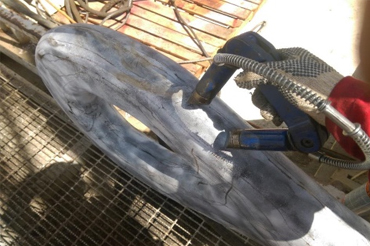MAGNETIC PARTICLE TESTING (MPT)
EIWAA Marine Services is a best NDT Company in Saudi Arabia offers all the conventional and Advanced NDT Services. EIWAA Marine Services is approved by major IACS Classification Societies and Ports of Saudi Arabia to provide NDT Testing Service and Non-Destructive Testing Evaluation by Magnetic Particle Testing services at Saudi Arabia Ports. A comparatively easy test technique that can be used on ferromagnetic materials such as finished goods, billets, castings and forgings is magnetic particle testing, often known as magnetic particle inspection. As the particles are drawn to the magnetic leakage field produced by the part’s discontinuities, patterns are formed by the magnetic particles, which shall be applied to the component for magnetization. MPI Testing with magnetic particles is done with either wet (suspended in a fluid) or dry powder forms; visible or fluorescent particles are used. We are using white contrast paint and Black ink from authorized brands of Magnaflux or Chemetall to increase the visibility of visible. EIWAA Oil and Gas Services uses MPI Testing yokes and consumables from reputable manufacturers who ensure their products meet code requirements. Our NDT technicians are trained professionals and are in accordance with a written practice that complies with the requirements of ASNT-SNT-TC-1A. By using MPI Testing Services, we can find discontinuities of surface or subsurface of parent material and welding.

Surface temperature: Before performing the examination, it shall be verified that the temperature of the part shall not exceed 600°F for dry particle examinations or 135° F for wet magnetic particle examinations. The temperature shall not exceed 600ºF (316ºC) for dry particles and 122ºF (50ºC) for wet particles.
Lighting: For dry particle and wet non fluorescent magnetic particle examination, adequate visible light shall be available. It shall be a minimum of 100 foot candles (1000 lux) and measured by a lux meter on a daily basis. For fluorescent particle examination, the testing shall be performed in a darkened area with an ambient light intensity of 2 foot candles (20 lux) maximum. The black light used shall be allowed to warm up for a minimum of 5 min. prior to use or measurement of the intensity of the ultraviolet light emitted. The black light intensity shall be measured with a black light meter prior to use, whenever the light’s power source is interrupted or changed, and at the completion of the examination or series of examinations. A minimum of 1000μW/cm² on the surface of the part being examined shall be required. The black light intensity shall be measured once in 4 hr, whenever the workstation is changed, or after change of filter or bulb. The readings shall be recorded on a log sheet and kept with the black light unit at all times and monitored for intensity fading before each usage. As specified by the client, required black light level may be as much as 4000μW/cm² for applications such as detection of hydrogen induced cracking.
